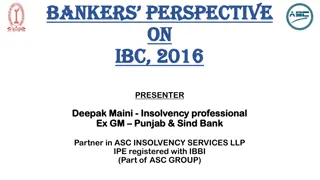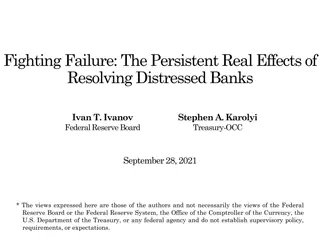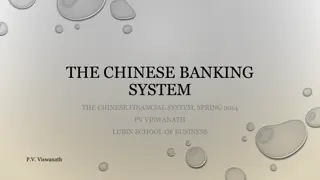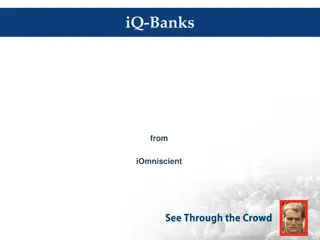Understanding Different Types of Banks in India
Explore the various types of banks in India, including Scheduled Banks, Non-Scheduled Banks, Commercial Banks, and Cooperative Banks. Learn about their classifications, regulations, and primary functions as detailed by experts in the field. Discover the significance of banking operations as governed by the Reserve Bank of India Act, 1934, and the Banking Regulation Act, 1949.
Download Presentation

Please find below an Image/Link to download the presentation.
The content on the website is provided AS IS for your information and personal use only. It may not be sold, licensed, or shared on other websites without obtaining consent from the author. Download presentation by click this link. If you encounter any issues during the download, it is possible that the publisher has removed the file from their server.
E N D
Presentation Transcript
Bank and Its Types BY DR PRAMOD KUMAR
Meaning of the Bank According to Sayers bank is an institution whose debts are widely accepted is settlement of other peoples debts to each other According to Sir John Paget a bank or banker is a corporation or person(or group of persons) who accepts money on current account, pays cheques drawn upon such account on demand and collects cheques for customers
Banking Banking Banking as accepting, for the purpose of lending or of investment of deposits of money from the public, repayable on demand or otherwise or withdrawable by cheque, draft order or otherwise . Regulation Act of India, 1949, defines The Reserve Bank of India Act, 1934 and the Banking Regulation Act, 1949 govern the banking operations in India.
Types of Bank There are two broad categories under which banks are classified in India- Scheduled Bank and Non Scheduled Bank. Scheduled Bank- Scheduled Banks are the banks which are covered under the Second Schedule of the Reserve Bank of India Act, 1934. To qualify for being a scheduled bank, a minimum of 5 lakh paid-up capital is required on the bank s behalf.
Non Scheduled Bank The banks which are not included in the second schedule of RBI Act, 1934. Non-Scheduled Banks are also required to maintain the cash reserve requirement, not with the RBI, but with them. Their banking activities are limited, for example they can not deal in foreign exchange. The share of these banks are almost nill.
Types of Scheduled Banks The scheduled banks include Commercial Banks and Cooperative Banks. The Banks, Small Finance Bank, Foreign Banks, Private Sector Banks and Public Sector Banks. commercial banks include Regional Rural PAYMENTS BANK is a new introduction to this category. Cooperative banks include Urban and Rural Banks.
Commercial banks Commercial Banks are regulated and managed under the Banking Regulation Act, 1949. These are profit making banks based on their business model. Granting loans to the government, general public, and corporate and accepting deposits counts as the primary function.
Types of Commercial Banks There are four types of commercial banks: 1)Public Sector Banks 2)Private Sector Banks 3)Foreign Banks 4)Regional Rural Banks(RRB)
Public Sector Banks Scheduled Banks consists public sector banks, These are the nationalized banks and account for more than 75 per cent of the total banking business in the country. At least 51% ownership is vested with the government. Majority of stakes in these banks are held by the government. In terms of volume, SBI is the largest public sector bank in India and after its merger with its 5 associate banks (as on 1stApril 2017) it has got a position among the top 50 banks of the world.
Classification of Public sector Banks Public Sector banks can be further classified as: SBI & Associates: Other Nationalized Banks: Other Public Sector Banks: IDBI Bank and Bhartiya Mahila Bank, which are categorized as other public sector banks.
Private Sector Banks The private-sector banks are banks where majority of their ownership is held by private shareholders and not by the government. sector banks are controlled by private promoters and they are free to operate as per market forces. Private owned, managed and They are also regulated by guidelines issued by Central Banks from time to time. ICICI Bank, Yes Bank and Axis Bank. Private sector banks in India can be classified as Private Indian Banks (J&K Bank Ltd. And Lord Krishna Bank Ltd) & Private Foreign Banks.
Foreign Banks Foreign banks have their registered and head offices in a foreign country but operate their branches in India. The RBI permits these banks to operate either through branches; or through wholly-owned subsidiaries. The primary activity of most foreign banks in India has been in the corporate segment. However, some of the larger foreign banks have also made consumer financing a significant part of their portfolios. These banks offer products such as automobile finance, home loans, credit cards, household consumer finance etc. Foreign banks in India are required to adhere to all banking regulations, including priority-sector applicable to domestic banks. lending norms as
Regional Rural Banks on the recommendation of Narasimham Committee(1975), The government of India set up Regional Rural Banks (RRBs) on October 2, 1975. The objective was to provide credit and other facilities to small and marginal farmers, agricultural labours and artisans. These banks grant loan only to the rural agriculture sector and small artisans. They are governed by Regional Rural Bank Act, 1976. These cooperative banks. banks are to supplement the effort of
Cooperative Banks Cooperative banks are private sector banks. Co-operative banks are also mutual savings banks meant essentially for providing cheap credit to their members. A cooperative bank is a voluntary association of members for self-help and caters to their financial needs on a mutual basis. They accept deposits and make mortgage and other types of loans to its members. These banks are also subject to control and inspection by the Reserve Bank of India but they are generally governed by a different statue, which is more flexible and easy to comply with compared to central bank acts. In India, they are governed by the provisions of State Cooperative Societies Act. They function on no profit no loss basis
Import-Export Banks Import-Export government like central banks to promote trade activities in import and export. banks are generally setup by They support exporters and importers by providing financial assistance, acting institution, coordinating working of other institutions engaged in export and import to facilitate the growth of international trade. as principal financial They provide traditional export finance and also do financing of export oriented units. Some examples are Export-Import Bank of India (EXIM Bank), Export Import Bank of the United States.
Merchant Bank It means Any person who is engaged in the business of issue management either by making selling, buying or subscribing consultant, advisor or rendering corporate advisory services in relation to such issue management. arrangements securities regarding manager to as Merchant bank is a financial institution that primarily deals with commercial banking needs of international finance, long term loan for companies provides underwriting of stock. consulting services and It also acts as an intermediary between the issuers and the ultimate purchasers of the securities in the primary market. It has been statutory brought within the framework of the Securities and Exchange Board of India (SEBI).
Foreign bank National Grindlays Bank started merchant banking in 1967. Then Citibank in 1970 and State Bank of India in 1972 started Merchant banking. Later ICICI setup its merchant banking division followed by Bank of India, Bank of Baroda et.























